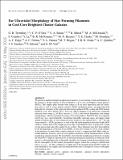Far-ultraviolet morphology of star-forming filaments in cool core brightest cluster galaxies
Author(s)
Tremblay, G. R.; O'Dea, C. P.; Baum, S. A.; Mittal, R.; Combes, F.; Li, Y.; McNamara, B. R.; Bremer, M. N.; Clarke, T. E.; Donahue, M.; Edge, A. C.; Fabian, A. C.; Hamer, S. L.; Hogan, M. T.; Oonk, J. B. R.; Quillen, A. C.; Sanders, J. S.; Salomé, P.; Voit, G. M.; McDonald, Michael A.; ... Show more Show less
DownloadFar ultraviolet.pdf (13.64Mb)
OPEN_ACCESS_POLICY
Open Access Policy
Creative Commons Attribution-Noncommercial-Share Alike
Terms of use
Metadata
Show full item recordAbstract
We present a multiwavelength morphological analysis of star-forming clouds and filaments in the central (≲50 kpc) regions of 16 low-redshift (z < 0.3) cool core brightest cluster galaxies. New Hubble Space Telescope imaging of far-ultraviolet continuum emission from young (≲10 Myr), massive (≳5 M⊙) stars reveals filamentary and clumpy morphologies, which we quantify by means of structural indices. The FUV data are compared with X-ray, Lyα, narrow-band Hα, broad-band optical/IR, and radio maps, providing a high spatial resolution atlas of star formation locales relative to the ambient hot (∼107–8 K) and warm ionized (∼104 K) gas phases, as well as the old stellar population and radio-bright active galactic nucleus (AGN) outflows. Nearly half of the sample possesses kpc-scale filaments that, in projection, extend towards and around radio lobes and/or X-ray cavities. These filaments may have been uplifted by the propagating jet or buoyant X-ray bubble, or may have formed in situ by cloud collapse at the interface of a radio lobe or rapid cooling in a cavity's compressed shell. The morphological diversity of nearly the entire FUV sample is reproduced by recent hydrodynamical simulations in which the AGN powers a self-regulating rain of thermally unstable star-forming clouds that precipitate from the hot atmosphere. In this model, precipitation triggers where the cooling-to-free-fall time ratio is tcool/tff ∼ 10. This condition is roughly met at the maximal projected FUV radius for more than half of our sample, and clustering about this ratio is stronger for sources with higher star formation rates.
Date issued
2015-06Department
MIT Kavli Institute for Astrophysics and Space ResearchJournal
Monthly Notices of the Royal Astronomical Society
Publisher
Oxford University Press
Citation
Tremblay, G. R.; O'Dea, C. P.; Baum, S. A.; Mittal, R.; McDonald, M. A.; Combes, F.; Li, Y. et al. “Far-Ultraviolet Morphology of Star-Forming Filaments in Cool Core Brightest Cluster Galaxies.” Monthly Notices of the Royal Astronomical Society 451, no. 4 (June 29, 2015): 3768–3800.
Version: Original manuscript
ISSN
0035-8711
1365-2966